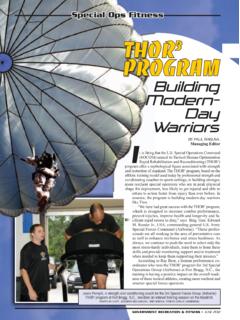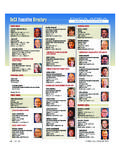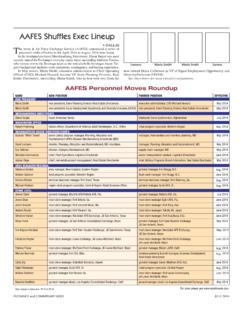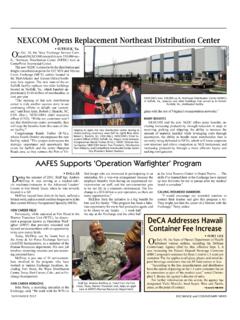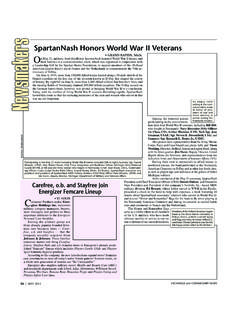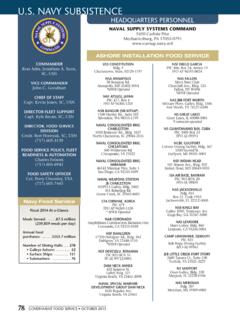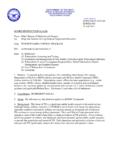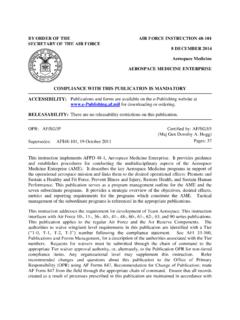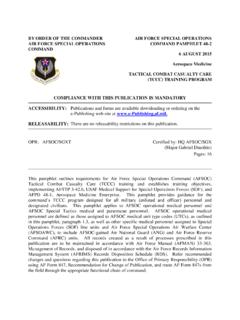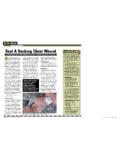Transcription of Special Ops Fitness Tactical Athletes… - ebmpubs.com
1 For Special Operations Command (SOCOM), providing training, equipment and resources that are at the tip of the spear is of utmost priority, as SOCOM Tactical athletes are responsible for completing some of the most chal-lenging missions in the military, under incredible physical and mental stress, in unimaginably hostile and unforgiving environments. Our mission is to provide optimum sports medicine, rehabilitative care and medical material support to all active-duty personnel of Naval Special Warfare Group One, said Mark Rogow, who is the Sports Medicine program manager for Naval Special Warfare Group One (NSWG1), NAB Coronado, Calif. We provide musculoskeletal support to those who sustain injuries of any kind by providing clinical evaluation, diag-nosis, treatment and rehabilitation by a highly trained and specialized team of experts. The plan of care is designed to achieve the maximum level of function in a minimum amount of time, taking into account the safety of the individual and operational commitments of the NSW population.
2 Rogow explained that a plan of care is individual-ized and performed in conjunction with other providers within the NSW medical system. Each war fighter is treated and assessed at the earliest opportunity, and transitioned to the Human Performance Special -ists to implement an individualized training regimen through our Bridge Program. This allows recovering Tactical athletes to maintain and/or improve Fitness , strength and resiliency of unaffected body regions while completing their treatment and recovery from musculoskeletal injury. This results in an expeditious return to full duty and peak Fitness for NSW war fighters that directly enhances command readiness and mission capability. By PAUL RAGUSAM anaging Special Warfare Building More Resilient WarriorsThe Sports Medicine Clinic is part of the Tactical Athlete Program (TAP) and the Logistics Support Unit Medi-cal Department Within TAP, we work closely with our Human Performance staff, which consists of strength coaches, a per-formance dietician and a sports-psych professional.
3 TAP is a SOCOM-funded program that provides the collegiate and professional sports medicine/human per-formance model across all of SpecOps. Naval Special Warfare Group One has a Sports Medicine Clinic and a Bridge Gym under the same roof, and both sup-port all training and rehabilitation needs. The Bridge Gym is the link between rehabilitation and our human performance team, Rogow explained. So there is not only a continuity in the program, but also a smooth transition from rehab back to either their teams or our facilities, which is where we have our human performance staff, and our strength coaches. We are doing Bridge programming across NSW within TAP. The Bridge Gym is home to the NSWG1 Bridge program, which is de-signed to augment the NSW operator s overall The Tactical Athlete Program (TAP) is founded on the collegiate and profes-sional sports training model with a strong reliance on sports Bridge Gym provides ample strength and cardio equipment for the NSW community to use at NAB Coronado.
4 GOVERNMENT RECREATION & Fitness JUNE 2014 Special Ops Fitnessbeen a huge asset that I truly appreciate, and it positively impacts what we do and helps us achieve our overarching mission. THE ATHLETIC MODELThe Sports Medicine and Human Performance programs at Coronado represent the new direction SOCOM has taken over the past decade in re-gard to training and healing these elite Tactical athletes. The past decade of war has cer-tainly impacted our NSW personnel, and it was with this in mind that leader-ship created programs with increased emphasis on resiliency, noted Rogow. So, in the last 10 years or so, the athletic model for training, which is based on proven sports medicine and human performance principles, has been creeping into their community and they deserve this kind of care, attention and prepa-ration. Our government and taxpayers pay a lot of money toward their education, their training and maintaining them and their careers, so it is vitally important that we give them every opportunity to become more resilient, to become more efficient and to be able to, hopefully, rehabilitate faster if injuries do occur.
5 Rogow pointed out that the same approach that has become a staple within professional sports and Division One, Two and Three Athletics, is now becoming the norm throughout SOCOM, and the results have been encouraging. From what I have seen the last three-plus years here at Coronado, I can tell this community, and the SEALs them-selves, are incredibly appreciative of our time with them, and the experience that we bring to them, and that is not just on the sports medicine side, but on the human performance side, and with our performance dieticians, and we now have a sports-psych professional on board. These are all commonplace in professional and collegiate athletics, and now we have the opportunity to provide the very best to these Tactical athletes here. We also give this same attention and experience to our enablers those who help our operators on a daily basis, both at home and when forward deployed.
6 Rogow said that over the last few years he has seen how this smarter approach to training and rehabilitation has positively impacted the NSW community, especially from the stand-point that they can do it right here on base. They don t have to go to downtown San Diego to the Naval Medical Center to get their care. They can come right in here, get the care they need, get their training or rehab in and then get back to work, saving them time and money, as well as allowing us to tailor the program to meet their specific needs daily, weekly or according to their training cycle or operational demands. LEVERAGING TECHNOLOGY Equipment and modalities in the Sports Medicine Clinic include numerous therapeutic and diagnostic modalities, as well as the latest in new assessment and treatment technology, including: LightForce Class IV Laser; HydroWorx Therapeutic conditioning, both following injury and/or surgical intervention, as well as supporting those personnel who have not suffered an injury, yet have a body part, joint or multiple areas of dysfunction and need assistance with improving their mobility, function, strength and/or stability.
7 This program improves the efficiency of rehabilitation and recovery while making a significant impact on the individual s performance and resiliency, Rogow explained. This program is a partnership between Tactical Athlete Center (TAC) Sports Medicine and TAC Human Performance. This program is de-signed to facilitate the SEAL s rehabilitation by bridging the gap between Sports Medicine and the Human Performance Program, enhancing the recovery of the SEAL, and returning them to operations as quickly and safely as possible. All of the strength coaches on the Human Performance staff are required to have and maintain the National Strength and Conditioning Association s (Certified Strength and Conditioning Specialist), and many strength coaches have other certifications affiliated with USA Weightlifting, Kettlebell, CrossFit, Functional Movement Screen (FMS) and others. Human Performance staff provide Fitness and FMS as-sessments, and the Sports Medicine team provides numerous movement assessments, which include, but are not limited to: Orthopedic Screen (a full-body musculoskeletal assess-ment), Selective Functional Movement Assessment (SFMA), Postural Restoration (PRI), Y-Balance Upper and Lower Body Assessment, as well as Gait, Balance and Jump testing with the OptoJump System.
8 As part of our TAP program, we have on staff certified athletic trainers, physical therapists and strength coaches, and we all reach out to our peers to do our best to stay up on the latest technologies and best practices that are in the sports medicine community, noted Rogow. When it comes to training and education, our command has been outstanding in regard to supporting bringing in subject matter experts on a variety of topics and areas, from evaluation techniques to treatment and therapeutic exercise prescription to taping techniques. One thing that is fascinating about working with Special Warfare is that we have not met a professional out there who does not want to help our operators or active duty. That good will has Class IV laser technology is used to treat muscle strains, and pro-vide pain relief, reducing inflammation and improving blood flow. GOVERNMENT RECREATION & Fitness JUNE 2014 Special Ops Fitnesseveryday function.
9 What is great is that they pick up on it so quickly, so they are getting valuable real-time information and they are reducing their pain. Rogow pointed out that by compensating for an injury by slightly limping or changing one s gait one can create stress somewhere else, which slows down the whole rehab process of getting them back up to full function. We can use this technol-ogy over a 10-meter span, for example, and test vertical jump and broad jump, and evaluate their gait over a 10-meter distance. And, we can do that with them wearing all of their equipment, which can weigh upwards of 45, 50 and 60-plus pounds, so we can simulate what it is like for them downrange. Other advanced technology being used at the clinic in-cludes the Alter-G anti-gravity treadmill, which is used a lot by those who are rehabbing injuries knees, lower back, ankles, for example. It is also used by those who are trying to reduce the impact on their body during training, such as those who are involved in marathons or ultra marathons and triathlons, and it is a great alternative for those looking to get in their running and conditioning, while decreasing the stress on their joints.
10 The Sports Medicine Clinic also recently added a Neuro-Com system, which will be used in the near future to assess and treat those who are suffering from balance and proprio-ception issues as a result of a traumatic brain injury (TBI) or other injury. Staff members also help NSW personnel with improving their balance and proprioception using interactive games through the Wii and the Monitored Rehab Systems (The Cube) from CDM Sport. In addition to the equipment in the Sports Medicine Clinic, NSWG1 uses the Bridge Gym, which houses cardio, strength and other exercise equipment, including VersaClimbers, Con-cept2 rowing machines and SkiErg, Woodway Force Treadmills, Cybex Arc Trainers, Life Fitness ellipticals, treadmills and cable crossovers, stair-climbers, Keiser Functional Trainers, TRX, Jacobs Ladder, Power Lift Squat Racks, Sorinex GHD, True Fitness Stretch Station, and PowerPlate and VibePlate vibration platforms.
